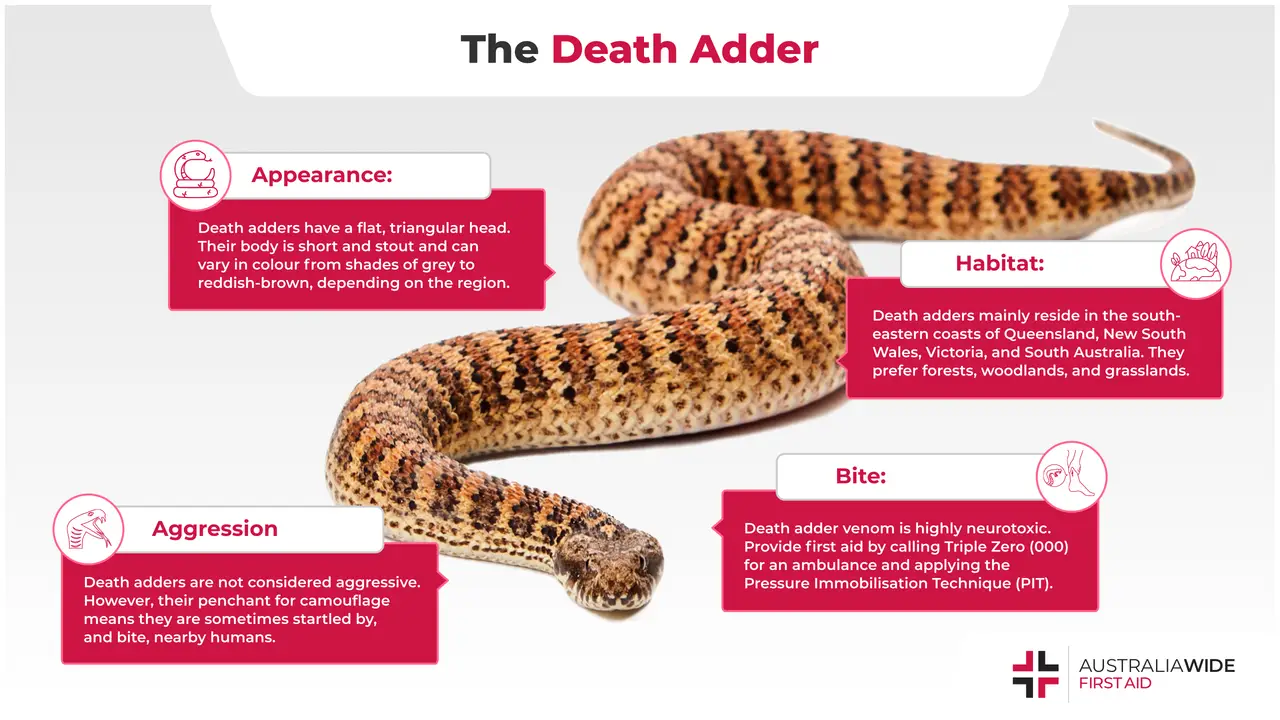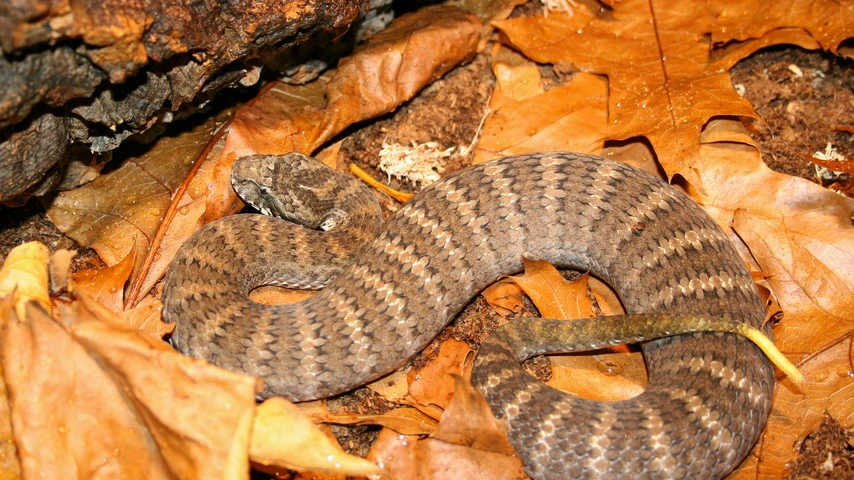Snake Facts: The Death Adder


Discovered by French naturalist Francois Marie Daudin, the Death adder is one of the most venomous snakes in the world, and is the only species in the Acanthophis genus.
Native to Australia, New Guinea and nearby islands, the existence of Death adders is at threat due to ongoing invasion by the Australian cane toad.
The Death adder, otherwise known as Common death adder, is native to Australia and mainly resides in the south-eastern coasts of Queensland, New South Wales, Victoria, and South Australia.
Several species of Death adders can be found in other parts of Australia, such as the Northern Territory and Western Australia – however, they generally live in areas abundant with forests, woodlands, and grasslands.
As one of the most venomous land snakes in Australia and globally, the death rate from a Death adder bite was approximately 50% prior to the development of the Death adder anti-venom in 1958.
However, due to human encroachment into Death adder habitat, much research has gone into these wild animals to mitigate human-Death adder conflicts. In addition to this, Death adders are now being threatened by the introduction of Cane toads in Australia, which has resulted in a drop of Death adder populations by almost 89%.
Death adders can give birth to up to 24 live young between the summer months of December and March. New-born Death adders are around 12cm in length from the tip of their snout to the base of their tail. Females reach reproductive maturity at roughly 2 – 4 years old. Males, meanwhile, reach reproductive maturity at 2 years old.

Death adders are quite distinctive in their figure. Unlike most snakes, which are renowned for their long, thin bodies and sharp heads, Death adders are typically short and stout – the only thin parts of their body is their neck and tail, the latter of which has a curved tip.
Death adders are also known for their triangular-sized head. Some other common identifiers of the Death adder are listed below:
In contrast with other native Australian snakes, which are mostly active foragers, the Death adder waits for its prey by sitting still in one place and camouflaging itself under leaves.
Even when approached by predators, this snake will often remain motionless as a defence mechanism. This has subsequently earnt them the alternate name of the ‘Deaf adder’, based on the belief that they cannot hear approaching humans.
Death adders often feed on small animals such as frogs, lizards, and birds. Once their prey is within striking distance, these snakes will react with lightning speed and inflict a highly venomous bite.
Death adders do sometimes twitch their tail close to their head as a lure for curious animals. The Death adder will then wait for its prey to die from envenomation before eating it.
Death adder venom contains a highly dangerous neurotoxin that can cause human death six hours after the initial bite, while smaller mammals such as dogs experience worse reactions and on average live only 20 minutes after the initial bite.
The average venom output by a Death adder is around 85mg with a maximum recorded venom output of 235mg. Due to their relatively large fangs and toxic venom, these snakes are efficient killers that are to be feared.
Symptoms of a Death adder bite include:
Though Death adders are not considered aggressive, their penchant for camouflage means that they are sometimes startled by, and subsequently bite, humans who venture into their bushland habitats.
If you are bitten by a Death Adder, it is crucial to act as soon as possible to stop the venom from circulating through the body. Call Triple Zero (000) for an ambulance and perform the following first aid steps:
Please note, if the bite site is on an area of the body where a pressure bandage cannot be applied, make sure you maintain firm pressure. It is also important that you do not attempt to capture or kill the snake, nor to cut the bite and suck the venom out. More information about the dos and don'ts of snake bite first aid can be found in our Article Library.
We run certified First Aid courses throughout all major Australia citys. Find a location near you.
Some people can have a severe allergic reaction when bitten by a Death adder. This is called anaphylaxis, a condition that can be fatal in as little as 15 minutes. Symptoms include:
If the casualty begins exhibiting any of the above symptoms, call Triple Zero (000) for an ambulance, consult the Australian Resuscitation Council's anaphylaxis treatment guideline, and follow DRSABCD and prepare to perform CPR.
Death adders are extremely dangerous, and caution should be exercised whenever treading into Death adder habitat.
With the invention of antivenom and the development of modern medicine, the mortality rate from Death adder bites is rather low, and most of those that occur in urban areas do not contain any venom.
However, as humans continue to encroach on the habitat of wild animals, it is important to develop the knowledge and skills to provide first aid in any medical emergency. To learn more about identifying and treating bites from some of Australia’s most venomous snakes, book a First Aid course with us today.

March 11, 2025
Darwin, the tropical capital of Australia’s Northern Territory, is home to a rich diversity of wildlife - including an impressive array of spiders. From the sprawling webs of golden orb-weavers to the cryptic camouflage of trapdoor spiders, these arachnids play a vital role in the local ecosystem. While some may inspire fear, the majority are harmless and even beneficial, helping to control insect populations.

September 4, 2024
Cat bites, while often underestimated, can lead to serious health complications if not treated promptly and properly. Cats' mouths harbour a variety of bacteria that can cause infections in humans.

April 1, 2024
Encounters with wildlife can often be thrilling, but when it comes to the creature known as the drop bear, the experience can quickly turn dangerous. A sharp increase in recent attacks prompts the need for understanding proper first aid procedures in case of an attack.